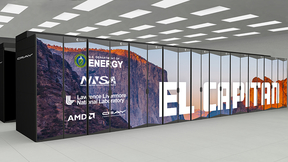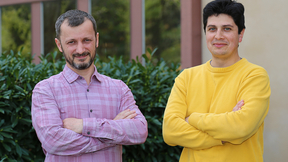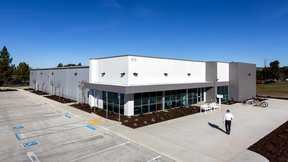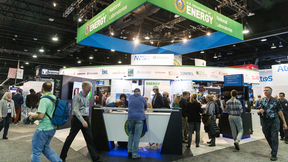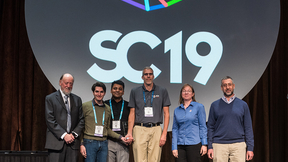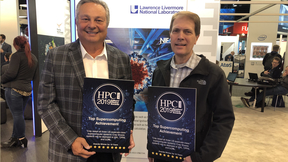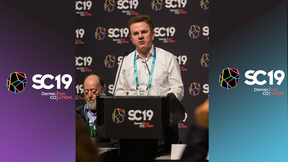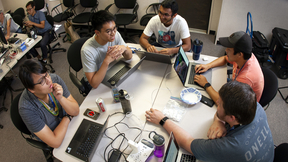Back
Computing
LLNL and HPE to partner with AMD on El Capitan, projected as world’s fastest supercomputer
Lawrence Livermore National Laboratory (LLNL), Hewlett Packard Enterprise (HPE) and Advanced Micro Devices Inc. (AMD) today announced the selection of AMD as the node supplier for El Capitan, projected to be the world’s most powerful supercomputer when it is fully deployed in 2023. With its advanced computing and graphics processing units (CPUs/GPUs), El Capitan’s peak…
Lab team sizzles at DOE Grid Optimization Competition
A team of computer scientists and mathematicians from Lawrence Livermore National Laboratory (LLNL) bested more than two dozen teams to place first overall in Challenge 1 of the Department of Energy’s (DOE) Grid Optimization (GO) Competition, an ongoing series of contests aimed at developing a more reliable, resilient and secure U.S. electrical grid and solving complex…
Deep learning may provide solution for efficient charging, driving of autonomous electric vehicles
The future of commuter traffic probably looks something like this: ride-hailing companies operating fleets of autonomous electric vehicles alongside an increasing number of semi-autonomous EVs co-piloted by humans, all supported by a large infrastructure of charging stations. This scenario is particularly likely in California, which has committed to reducing carbon…
Media advisory: LLNL, NNSA to dedicate new Advanced Manufacturing Laboratory
WHO: Leaders from Lawrence Livermore National Laboratory (LLNL) and the National Nuclear Security Administration (NNSA), industry partner representatives and Laboratory experts in advanced manufacturing and 3D printing. WHAT: Lawrence Livermore National Laboratory will host a dedication ceremony and media tour of the Advanced Manufacturing Laboratory (AML), a state-of-the…
LLNL’s presence in HPC shines bright at SC19
The 2019 International Conference for High Performance Computing, Networking, Storage, and Analysis— better known simply as SC19 — returned to Denver, and once again Lawrence Livermore National Laboratory (LLNL) made its presence known as a force in supercomputing. The conference, attended by nearly 14,000 people representing 118 countries, kicked off with all-day…
LLNL-led team awarded Best Paper at SC19 for modeling cancer-causing protein interactions
A panel of judges at the International Conference for High Performance Computing, Networking, Storage and Analysis (SC19) on Thursday awarded a multi-institutional team led by Lawrence Livermore National Laboratory computer scientists with the conference’s Best Paper award. The paper, entitled “Massively Parallel Infrastructure for Adaptive Multiscale Simulations: Modeling…
LLNL wins 2019 HPCwire Readers’ and Editors’ Choice Awards for El Capitan
Lawrence Livermore National Laboratory (LLNL), along with the Oak Ridge and Argonne national laboratories and Cray Inc., garnered HPCwire Readers’ and Editors’ Choice Awards for Top Supercomputing Achievement for 2019. The awards recognize the announcements earlier this year of the Department of Energy’s first three exascale-class machines: Aurora, Frontier and El Capitan…
Upgrades coming to LLNL’s Corona computing cluster
Lawrence Livermore National Laboratory (LLNL) is collaborating with Penguin Computing Inc. and graphics card manufacturer AMD to upgrade its unclassified computing cluster Corona to roughly double the amount of graphics processors (GPUs) the system previously had. The upgrade will provide significantly greater performance and bring additional capabilities in artificial…
Penguin/Intel 'Magma' computing cluster coming to LLNL
Lawrence Livermore National Laboratory (LLNL) is welcoming the newest addition to its already powerful supercomputing lineup, a commodity cluster system built by Penguin Computing Inc. that will perform vital calculations for the National Nuclear Security Administration (NNSA). Penguin Computing, along with its partners Intel and CoolIT, announced it has shipped LLNL’s…
New TOP500 List unveiled: Sierra stays No. 2 with six other LLNL supercomputers in top 100
The latest TOP500 List of the world's most powerful computers was released today at the 2019 International Supercomputing Conference for High Performance Computing, Networking, Storage and Analysis (SC19) in Denver. Lawrence Livermore National Laboratory’s (LLNL's) IBM/NVIDIA Sierra supercomputer held steady at the No. 2 spot, one of seven Lab systems to crack the top 100,…
LLNL to receive DOE funding for new HPC4EI projects
The U.S. Department of Energy (DOE) today announced the 12 projects awarded funding under the latest solicitation for the High Performance Computing for Energy Innovation Program (HPC4EI), a public/private collaboration that seeks to leverage DOE’s high performance computing facilities at national labs for industry to improve energy efficiency and streamline manufacturing…
Energy Department announces $4 million for High Performance Computing for Energy Innovation
Today, the U.S. Department of Energy (DOE) announced up to $4 million for new projects to support manufacturers in improving energy efficiency, increasing productivity and accelerating manufacturing innovation. The High Performance Computing for Energy Innovation (HPC4EI) Initiative, managed by DOE’s Office of Energy Efficiency and Renewable Energy (EERE), is seeking…
Lab leads effort to model proteins tied to cancer
Computational scientists, biophysicists and statisticians from Lawrence Livermore National Laboratory (LLNL) and Los Alamos National Laboratory (LANL) are leading a massive multi-institutional collaboration that has developed a machine learning-based simulation for next-generation supercomputers capable of modeling protein interactions and mutations that play a role in…
LLNL team achieves largest graph analytics to date
Whenever Amazon makes a shopping recommendation based on past purchases, Facebook figures you might know friends of friends or Instagram decides who qualifies as an “influencer,” they’re using tools called graph analytics to determine those multiple threads of connections. Besides broad usage in the tech industry, graph analytics also have national security applications,…
Energy Department, Weill Foundation sign MOU to advance AI for biomedicine, health research
At an event held Monday at Lawrence Livermore National Laboratory, U.S. Secretary of Energy Rick Perry and Sandy Weill, founder of the Weill Family Foundation, signed a memorandum of understanding (MOU) to formally initiate a public-private partnership for artificial intelligence (AI), neurological disorders and related subjects. The partnership will apply DOE-fueled AI…
Hackathoners put coding skills to the test
College students are used to pulling all-nighters. For Lawrence Livermore National Laboratory summer intern Amar Saini, a recent graduate of the University of California, Merced, LLNL’s Summer Hackathon was a 24-hour, caffeine-fueled marathon of coding, diagramming and problem solving. Although Hackathon participants aren’t required to stay overnight and are strongly…
'Quantum annealer' shows promise in study
An international team of researchers, including Lawrence Livermore National Laboratory (LLNL) physicist Arjun Gambhir, has developed a new algorithm for solving polynomial systems of equations using a type of quantum computer called a "quantum annealer." The team systematically examined how this method scales when facing increasingly difficult mathematical equations, with…
DOE/NNSA, Lab announce partnership with Cray to develop NNSA's first exascale supercomputer
The Department of Energy (DOE), National Nuclear Security Administration (NNSA) and Lawrence Livermore National Laboratory (LLNL) today announced the signing of contracts with Cray Inc. to build the NNSA’s first exascale supercomputer, "El Capitan." El Capitan will have a peak performance of more than 1.5 exaflops (1.5 quintillion calculations per second) and an…
DOE/NNSA, Lab announce partnership with Cray to develop NNSA's first exascale supercomputer
The Department of Energy (DOE), National Nuclear Security Administration (NNSA) and Lawrence Livermore National Laboratory (LLNL) today announced the signing of contracts with Cray Inc. to build the NNSA’s first exascale supercomputer, "El Capitan." El Capitan will have a peak performance of more than 1.5 exaflops (1.5 quintillion calculations per second) and an…
HPC4Manufacturing project aims at improving thin-film processes used in LED lights
Lawrence Livermore National Laboratory (LLNL) researchers are working with semiconductor chip manufacturer Applied Materials to improve a process for depositing thin-film materials on wafers that are used in high-efficiency LED lights and other products. The Department of Energy’s High Performance Computing for Manufacturing (HPC4Manufacturing) program is funding the…


